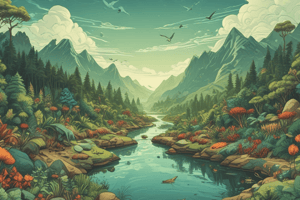Podcast
Questions and Answers
What type of organisms are considered producers in an ecosystem?
What type of organisms are considered producers in an ecosystem?
- Carnivores and herbivores
- Decomposers and parasites
- Plants, algae, and some bacteria (correct)
- Predators and scavengers
Which of the following is NOT an abiotic factor in an ecosystem?
Which of the following is NOT an abiotic factor in an ecosystem?
- Air
- Temperature
- Fungi (correct)
- Water
Which process describes how energy is transferred through an ecosystem?
Which process describes how energy is transferred through an ecosystem?
- Nutrient cycling
- Chemical transformation
- Water cycling
- Energy flow (correct)
What relationship describes the interaction between a clownfish and a sea anemone?
What relationship describes the interaction between a clownfish and a sea anemone?
Which ecosystem is characterized by the presence of rivers, lakes, and wetlands?
Which ecosystem is characterized by the presence of rivers, lakes, and wetlands?
In nutrient cycling, what role do decomposers play?
In nutrient cycling, what role do decomposers play?
Which feature is characteristic of both Arctic and Antarctic ecosystems?
Which feature is characteristic of both Arctic and Antarctic ecosystems?
What type of competition occurs when organisms vie for sunlight?
What type of competition occurs when organisms vie for sunlight?
Flashcards are hidden until you start studying
Study Notes
Ecosystems
Definition
- An ecosystem is a community of living and non-living components that interact with each other in a specific environment.
- It includes biotic factors (living organisms) and abiotic factors (non-living components).
Components of an Ecosystem
- Biotic factors:
- Producers (plants, algae, and some bacteria): convert sunlight into energy through photosynthesis.
- Consumers (herbivores, carnivores, omnivores): obtain energy by consuming other organisms.
- Decomposers (bacteria, fungi): break down dead organic matter into simple nutrients.
- Abiotic factors:
- Light
- Temperature
- Water
- Soil
- Air
- Nutrients (e.g., nitrogen, phosphorus)
Ecosystem Processes
- Energy flow:
- Energy from sunlight is converted into chemical energy through photosynthesis.
- Energy is transferred from one trophic level to the next through consumption.
- Nutrient cycling:
- Nutrients are absorbed by producers from the soil.
- Nutrients are passed from one trophic level to the next through consumption.
- Decomposers release nutrients back into the soil.
- Water cycling:
- Water is absorbed by producers from the soil.
- Water is lost through transpiration, evaporation, and runoff.
- Water is cycled back into the ecosystem through precipitation.
Types of Ecosystems
- Terrestrial ecosystems:
- Forests
- Grasslands
- Deserts
- Freshwater ecosystems:
- Rivers
- Lakes
- Wetlands
- Marine ecosystems:
- Coral reefs
- Estuaries
- Open ocean
- Arctic/Antarctic ecosystems:
- Tundra
- Ice sheets
Ecological Relationships
- Symbiotic relationships:
- Mutualism (e.g., clownfish and sea anemone)
- Commensalism (e.g., remora fish and shark)
- Parasitism (e.g., tapeworm and host)
- Predation:
- Predator-prey relationships
- Competition:
- Resource competition (e.g., for light, water, nutrients)
Definition of Ecosystem
- Ecosystem comprises living (biotic) and non-living (abiotic) components interacting in a specific environment.
Components of an Ecosystem
- Biotic Factors:
- Producers (e.g., plants, algae): Utilize photosynthesis to convert sunlight into energy.
- Consumers: Obtain energy by consuming other organisms, categorized as herbivores, carnivores, or omnivores.
- Decomposers (e.g., bacteria, fungi): Break down dead organic matter, recycling nutrients back into the ecosystem.
- Abiotic Factors:
- Include essential elements such as light, temperature, water, soil, air, and nutrients like nitrogen and phosphorus.
Ecosystem Processes
- Energy Flow:
- Sunlight energy transforms into chemical energy via photosynthesis, forming the base for food chains.
- Energy is passed through trophic levels from producers to consumers.
- Nutrient Cycling:
- Nutrients are absorbed by producers from the soil, facilitating growth.
- Through consumption, nutrients move through various trophic levels and are released back into the soil by decomposers.
- Water Cycling:
- Producers extract water from the soil, with processes like transpiration releasing it back into the atmosphere.
- Water is reintroduced to the ecosystem through precipitation, maintaining the water cycle.
Types of Ecosystems
- Terrestrial Ecosystems:
- Include forests, grasslands, and deserts, each with distinct flora and fauna.
- Freshwater Ecosystems:
- Contain rivers, lakes, and wetlands, characterized by varying water levels and biodiversity.
- Marine Ecosystems:
- Encompass coral reefs, estuaries, and the open ocean, hosting diverse aquatic life.
- Arctic/Antarctic Ecosystems:
- Feature tundra and ice sheets, adapted to extreme cold and unique conditions.
Ecological Relationships
- Symbiotic Relationships:
- Mutualism: Both species gain benefits (e.g., clownfish and sea anemone).
- Commensalism: One species benefits without affecting the other (e.g., remora fish on shark).
- Parasitism: One species benefits at the cost of another (e.g., tapeworm in a host).
- Predation:
- Reflects predator-prey dynamics, influencing population control and ecological balance.
- Competition:
- Species compete for limited resources such as light, water, and nutrients, impacting survival and growth.
Studying That Suits You
Use AI to generate personalized quizzes and flashcards to suit your learning preferences.




